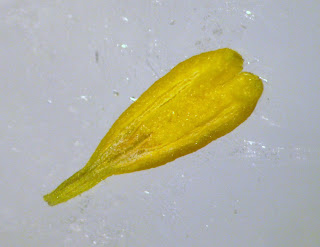BORAGINACEAE - Borage Family
---
The flowers from Borago officinale are showing the characteristic inflorescence of this family, helicoid cyme. Also notice how hairy the stems and leaves are? This is very common in the Borage family.
A flower from the above plant. It has five sepals, petals as well as five stamens. The petals are fused, and we coined it with the term "sympetalous corolla".
Longitudinal section through one of the flowers. The ovary has two carpels and each carpel divides into two lobes i.e. 1 ovary = 2 carpels = 4 lobes. When the ovary ripens, there will be 4 nutlets (the fruit type in this family).
A ripened ovary showing 4 nutlets.
A close up of one nutlet. In the key (step 3) it asks about the rim at the base of the nutlet. The above is an example of a thickened rim.
SOLANACEAE - Nightshade Family
---
This family has many important crops including tomato, potato, and tobacco. The above is a pepper plant (Capsicum sp.).
A Petunia sp. flower, note how well the petals are fused together.
A longitudinal section through the flower. Note the floral tube that encloses the stamens and pistil.
Another characteristic within the family is the glandular trichomes which may produces alkaloids to deter herbivory. This leaf also has prickles (extensions of cortex and epidermis) to further discourage eating of it.
Thank you to Yee Sing for the photo!
Another characteristic within the family is the glandular trichomes which may produces alkaloids to deter herbivory. This leaf also has prickles (extensions of cortex and epidermis) to further discourage eating of it.
Thank you to Yee Sing for the photo!
A Solanum sp. flower with connivent anthers (stuck together but not fused).
The fruit type in Solanaceae can be either capsule or berry. Tomatoes and bell peppers are both examples of berries.
The throne apple (Datura sp.) has some developing capsules.
Cross section of a tomato, what kind of placentation does it have?
A single Solanum sp. stamen. The poricidal dehiscences are the two longitudinal slits - the yellow coloured pollens and anthers makes them a little difficult to see.
Clicking on the picture will enlarge it.




Axile placentation in the tomato.
ReplyDelete